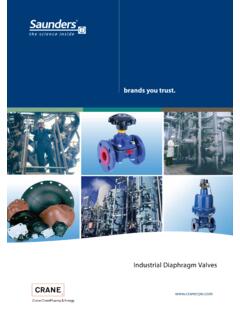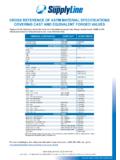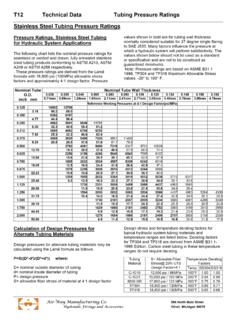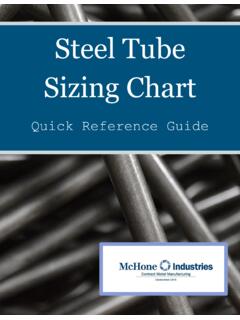Transcription of Jenkins Iron Valves - cranecpe.com
1 Jenkins Iron Valves3 Iron ValvesGeneral Data ..4 Iron Alloys ..5 Ratings Introduction ..6 Pressure/Temperature Ratings ..6 Gate Valve Features ..7 Globe and Angle Valve Features ..17 Swing Check Valve Features ..21 Stop-Check Valve Features ..26 Technical Data ..27 Installation Recommendations ..28 General IndexFigure Number IndexCanada Fig No. (US Fig No.) Page40BJ (40BJ) ..1441J (41J) ..14162J (923J) ..20203J (203J) ..15204J (204J) ..16339RJ (339J) ..24451J (325J) ..8452J (326J) ..9453J (650J) ..11454J (651J) ..12477LJ (477LJ) ..22523J (523J) ..10525J (100J) ..13540J (540J) ..25541J (541J) ..25587J (624J) ..22588J (623J) ..22590J (85J) ..232342J (613J) ..182344J (615J) ..194 General DataAdvanced manufacturing techniques and equipment, ongoing engineering research and product development, skilled craftsman, and over fourteen decades of experience in flow control are behind the quality and dependability built into every Jenkins catalog presents some of these products, namely: Jenkins ' line of industrial iron gate, globe and check Valves .
2 The information is presented in a comprehensive manner and includes material, construction, rating, principal dimensions, and weight data. Jenkins Valves are suitable for liquid working pressures specified on catalog pages only when used in hydraulic installations in which shock is absent or negligible. The sudden closure of a valve in a hydraulic system causes the body of liquid, which may be moving at a rate generally in excess of one foot per second, to stop instantaneously. As liquids are relatively incompressible, the sudden cessation of flow effects a rise in pressure considerably greater than the static working pressure. This pressure increase is termed SHOCK and may, in some cases, be sufficient to cause Valves or piping to increase due to shock is not dependent upon the working pressure in the system but upon the velocity at which the liquid is flowing. This pressure surge, or shock, severely limits design fact readily understandable if it is remembered that pressure rise resulting from arrest of flow may be as high as 60 psi for each foot per second initial velocity.
3 For example, installations of 100 psi and 1000 psi working pressures, with the same initial velocity of 10 feet per second, will be subject to the same increase in pressure (approximately 600 psi) due to instantaneous closure of a generally prevails in lines equipped with check or quick-closing Valves , or in lines supplied by reciprocating pumps. It may also be produced, to a lesser degree, by rapid closure of gate and globe Valves . Therefore, care should be exercised when closing Valves installed in liquid shock is likely to occur, the maximum shock pressure should be added to the working pressure of the line to determine working pressure of products in the , hydraulic installations should be equipped with air chambers or other types of shock absorbers to eliminate, as much as possible, increase in pressure due to Valves described in this section meet or exceed the MSS SP-82, MSS SP-70, MSS SP-71 and MSS SP-85 specifications for selection of materials for components of Jenkins Valves is based upon expert metallurgical, engineering, foundry and fabrication knowledge as well as on many years of usage experience.
4 Considerations affecting materials of parts which come in contact with the conveyed fluid include pressure, temperature and chemical composition of the fluid. The materials of moving parts that are subject to rubbing contact are selected on the basis of their resistance to wear, corrosion, seizing or galling, and on their frictional of materials to their full capability is assured by the use of stress analysis techniques that include extensive laboratory testing as well as the application of analytical theory. Stress levels for all materials used are maintained within the levels established by applicable codes, standards and catalog shows equivalent metric values to the customary imperial units. The soft conversion was arrived at by following MSS SP-86 Catalog illustrations are representative of a certain size of each line of product but do not necessarily represent all sizes in all & Design We reserve the right to institute changes in materials, designs, dimensions and specifications without notice in keeping with our policy of continuing product shown are approximate and are not guaranteed.
5 They represent the average weight of Jenkins Valve products as made from patterns in use at time weights were and Shock Working PressuresTestingMaterialsMetricationIllu strations, Weights and Material & Designs General Data5 Hydrostatic and Shock Working PressuresTestingMaterialsMetricationIllu strations, Weights and Material & Designs General DataCast IronUsed primarily for valve pressure retaining to 450 F (232 C). astm A126, Class BChemical Requirements Minimum MaximumSulphur ..% ..% Requirements Minimum MaximumTensile Strength, psi 31,000 Transverse Strength, lbs. 3,300 Deflection @ Center, IronA copper-free alloy used where physical properties of cast iron suffice but where greater corrosion resistance is required. Castings are marked 2NR. Ni-Resist is a registered trademark of the International Nickel Company, A436, Type 2 Chemical Requirements Minimum MaximumCarbon ..% ..% ..% ..% ..% ..% ..% ..% remainderTensile Requirements Minimum MaximumTensile Strength, psi 25,000 Brinell Hardness (3000 Kg) 118 174 Malleable IronUsed for Valves subjected to expansion and contraction stresses and A338.
6 Supplementary: astm A47, Grade 32510 Tensile Requirements Minimum MaximumTensile Strength, psi 50,000 Yield Point, psi 32,500 elongation in 2 inches, % 10 Jenkins Iron Alloys Iron Alloys6 Iron Valve Ratings Introduction to RatingThe pressure-temperature ratings shown below apply to class 125 and 250 iron Valves covered in this Ratings for Class 125 and 250 iron Valves are indicated on the relevant catalog page in this manner: ..PSI Steam, Basic Rating: : is the nominal steam rated pressure of the valve..Cold Working Pressure: where Cold Working Pressure is the maximum rated pressure of the valve at a temperature up to 150 F (65 C). The full range of allowable pressure and temperature is determined by referring to the main pressure-temperature chart Ratings for iron Valves falling outside Class 125 and 250 are indicated in various ways on the relevant catalog page. All ratings represent the maximum allowable non-shock pressure at the indicated temperature.
7 If the operating temperature of your system is not shown, the allowable pressure may be interpolated. The operating temperature of the valve is considered as the temperature of the media flowing through it. This temperature must not exceed the maximum allowable temperature as stated in the pressure-temperature chart RatingsJenkins Cast Iron Gate, Globe, Angle and Check Valves Imperial Units Class 125 250 Non-Shock-PSI Temp. F NPS NPS NPS NPS NPS 2"-12" 14"-24" 30"-48" 2"-12" 14"-24" -20 to 150 200 150 150 500 300 200 190 135 115 460 280 225 180 130 100 440 270 250 175 125 85 415 260 275 170 120 65 395 250 300 165 110 50 375 240 325 155 105 355 230 350 150 100 335 220 375 145 315 210 400 140 290 200 425 130 270 450 125 250 Metric Units Class 125 250 Non-Shock-kPa Temp. C NPS NPS NPS NPS NPS 2"-12" 14"-24" 30"-48" 2"-12" 14"-24" -29 to 66 1380 1030 1030 3480 2070 90 1310 930 790 3170 1930 110 1240 900 670 3030 1860 120 1210 860 570 2860 1790 140 1170 830 450 2720 1720 150 1140 760 340 2590 1650 160 1070 720 2450 1590 180 1030 690 2310 1520 190 1000 2170 1450 200 970 2000 1380 220 900 1860 230 860 1720 Manufacturers Standardization Society (MSS)Standard Practice SP-70, SP-71, SP-857 Introduction to RatingGate Valve FeaturesJenkins gate Valves offer the ultimate in dependable service wherever minimum pressure drop is important.
8 They serve as efficient stop Valves with fluid flow in either straight through design offers little resistance to flow and reduces pressure drop to a minimum. A disc actuated by a stem and handwheel moves up and down at right angles to the path of flow, and seats against two seat faces to shut off Valves are best for services that require infrequent valve operation, and where disc is kept either fully opened or closed. They are not recommended for throttling. With the usual type of gate valve, close flow regulation is impossible. Velocity of flow against a partly opened disc may cause vibration and chattering and result in damage to the seating surfaces. Also, when throttled, the disc is subjected to severe wire-drawing erosive valve in this section is classified by its pressure rating. All Valves designated as Class 125 and 250 comply with MSS SP-70 Industry trimmed Valves are recommended for steam, water, air and non-corrosive oil or gas.
9 All have bronze screwed-in seat rings and the discs are solid bronze in sizes 3" (80 mm) and smaller. In larger sizes, bronze rings are rolled into cast iron Valves have integral seats, some Valves have screwed in seat rings (discs are cast iron) and nickel-plated steel stems. They are recommended for oil, gas, gasoline, or fluids that corrode bronze but not iron or Dimensions of flanged end Valves conform to ASME in their pressure class. (See note re MSS SP-70 for flanged clamp gate Valves .)Flanged End Valves adhere to ASME Specification for their pressure and Bonnet Components are cast with rigorous control to astm A126 Class B Specification for are furnished on all Valves . Manual gear, hydraulic or motor operators and chainwheels can be supplied when - Rising stem Valves are equipped with backseats. It is recommend-ed that the backseat be used as a means for determining the full open valve position. For normal operation in the open position, the stem should be backed off so that the backseat is not in contact.
10 This permits the stem packing to assume its intended seal-ing function and not conceal unsatisfactory stem packing. In the event of stem packing leakage, the backseat can be used to stop stem leakage until circumstances permit a system shutdown and time for packing replacement. Stem packing replacement with the valve under pressure and back-seated represents a hazard and should not be undertaken. The hazard is magnified as fluid pressure or temperature increases or when the fluid is Wedge Gate Valve Discs - The strong, simple, single piece design with long disc guides is a proven performer for all service conditions, particularly suitable for conditions of severe turbulence and stem vibration. Seat and disc surfaces are accurately machined and tapered for shut-off without undue End Valves have precision cut threads in accordance with ASME Iron Gate Valves have an identification tag which indicates the valve catalog number and other pertinent data.









